I have been unexpectedly ambivalent about telling California gardeners about the Hardy Succulents book I co-authored with Gwen Kelaidis (Storey 2008). The reason I have been cautious about promoting the book in my home state is because for most people a hardy succulent is a small plant such as this Houseleek, Sempervivum ‘Faramir’ on the cover of the book.
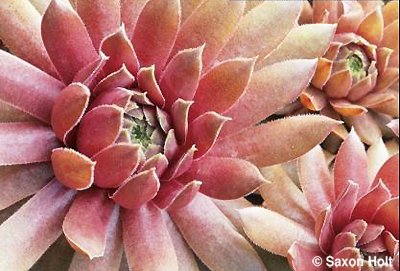
While Californians can, and certainly do, grow plenty of hardy plants, they all tend to grow much larger than in cold climates. It would be really unfair to show California gardens as examples in a book about hardy succulents. The camera does always lie but I do take my job as a garden photographer seriously and want gardeners to get information that guides them to success. Not only does that mean not showing California gardens in a book aimed at the rest of the country, it means being careful about showing photos taken in cold climates to gardeners here, especially to Southern California gardeners.
So, when the Southern California Horticultural Society recently asked me to make a presentation about my book, I took it as an opportunity to highlight the different ways succulents are used throughout the country. I hope GGW readers will enjoy the comparisons.
Here is a hardy succulent garden in Delaware.
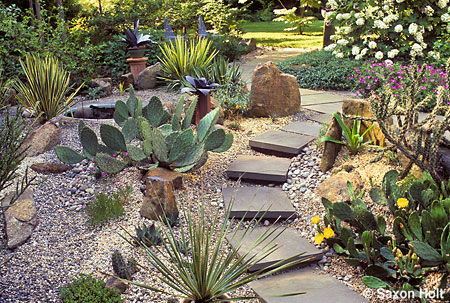
Eve Thyrum's hardy succulent garden
Like many expert gardeners, Eve Thyrum pushes the limits of her garden and will find a way to grow plants she loves. In a rock garden protected by a west facing wall of her house she can grow Opuntias and Yuccas – and worries every winter if it will be too cold or too wet. The path through her succulent garden is a series of flagstone pavers that encourages a slow thoughtful look at her collection.
A path through succulent garden Southern California garden might invite a long stroll:
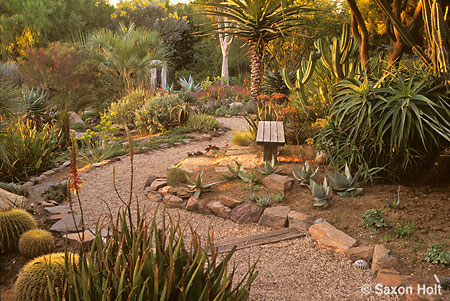
Patrick Anderson's garden
In Patrick Anderson’s garden near San Diego there is no reason to look down at your feet while you walk along the path. With just these two examples it becomes clear that the extreme differences of climate make for radically different ways to use succulents. In the zone 10 California garden there is no limitation to hardy succulents, and in fact tender Aloes become shrubs.
Sometimes gardeners in cold climates want the look of desert succulent garden:
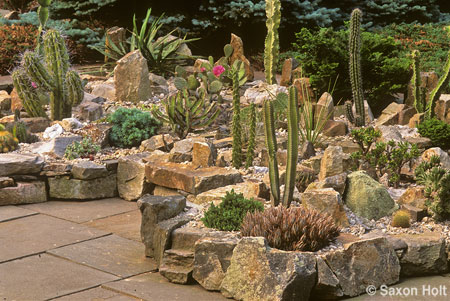
Connecticut "desert"
The only way this garden survives in Connecticut is by moving all the plants indoors in winter. All these cactus are in pots placed behind the low rock wall on the patio, then back filed with gravel. A wonderful testimony to the gardener’s passion and commitment to taking care of choice plants.
This same look is a low maintenance look in Southern California:
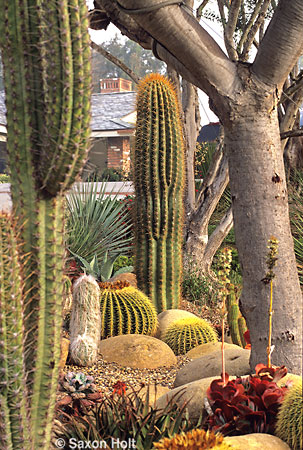
San Diego succulent garden
California gardeners sometimes don’t quite understand the great lengths some other gardeners will go to use succulents in their gardens. While succulents have undeniable appeal for their diverse shapes, colors, and textures, it takes a lot of effort to treat them as annuals as in this border of tender plants (with a non succulent Astelia).
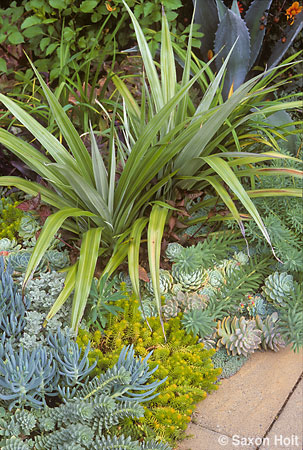
In California, a border of succulents can look like this, the 35 year old Ruth Bancroft garden in Walnut Creek:
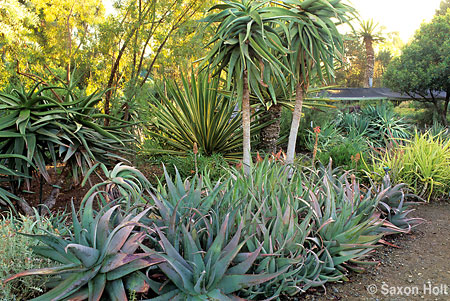
Ruth Bancroft garden
I used my presentation to remind the Southern California audience that succulents, like so many garden plants we fall in love with at a nursery, will get much bigger. Used as annual plants, succulents can make a fabulous single season summer display in a cold climate:

Succulents used as annual plants
Note the Agave attenuata in the upper part of that photograph – a fine bold foliage plant in a precious garden of tender succulents. Agave attenuata really becomes a bold foliage plant in Southern California:

Agave attenuata 'Boutin Blue'
I suppose the real lesson here is, for those who expect photographs to inspire their gardening – use a good bit of critical thinking when seeing a garden photograph. A small plant in a picture can become a big one in the garden; and a big plant in photograph may have been taken in a warmer climate than your own.
And when it comes to hardiness, unless you live in a tropical zone 11, there are always hardiness issues. I too, in California zone 9 have to be concerned about hardy succulents, or I would be growing Kalanchoe as a garden plant. Wouldn’t I like to add this to my border ?

Kalanchoe thyrsiflora
